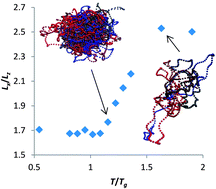Generalized localization model of relaxation in glass-forming liquids†
Abstract
Glassy solidification is characterized by two essential phenomena: localization of the solidifying material's constituent particles and a precipitous increase in its structural relaxation time τ. Determining how these two phenomena relate is key to understanding glass formation. Leporini and coworkers have recently argued that τ universally depends on a localization length-scale 〈u2〉 (the Debye–Waller factor) in a way that depends only upon the value of 〈u2〉 at the glass transition. Here we find that this ‘universal’ model does not accurately describe τ in several simulated and experimental glass-forming materials. We develop a new localization model of solidification, building upon the classical Hall–Wolynes and free volume models of glass formation, that accurately relates τ to 〈u2〉 in all systems considered. This new relationship is based on a consideration of the anisotropic nature of particle localization. The model also indicates the presence of a particle delocalization transition at high temperatures associated with the onset of glass formation.


 Please wait while we load your content...
Please wait while we load your content...